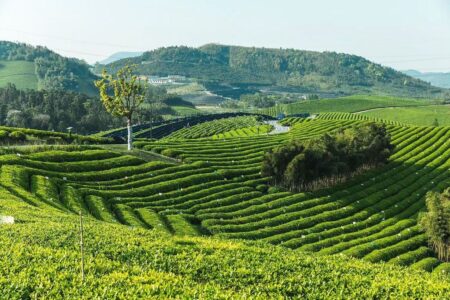Complications in Achieving Sustainability in Tea

Elephants take refuge at a tea plantation in Asia. Image courtesy of Anshuma Basumatary/University of Montana.
Achieving sustainability in tea is complicated by many factors, one being workers may who know what must be done but lack the resources to do so. These efforts are also often compounded by the fact that tea production impacts the most vulnerable populations including women, children and endangered wildlife.
Article by Anne-Marie Hardie.
The tea story is a complicated one, becoming increasingly convoluted when it ventures into the challenge of sustainability. This large-scale crop continues to provide a livelihood for some of the most impoverished areas in the world including Africa, Asia and select farms in South America. Challenges include over-fertilization, pesticide use, soil erosion, impoverished or detrimental working conditions and displaced wildlife. On a positive note, several organizations have taken note of some of the core challenges and are taking action to make a difference.
The 2030 Agenda for Sustainable Development brought to light that biodiversity needs to be at the centre of social, economical and environmental sustainability. Maintaining the natural diversity of an ecosystem has been linked to a reduction of pesticide use and other chemical inputs, which in turn has a positive impact on the water, air, and human health in the region. The biodiversity conversation has been largely centralized around the positive role of pollinators, birds and foliage. However, it is integral to consider the impact to all of the wildlife in the region, including those, like elephants, tigers and rhinos, that have previously been considered a hazard.
The Wildlife Friendly Enterprise Network (WFEN) is one company whose focus has been centred around decreasing the negative impact that agriculture has on vulnerable species. Founded in 2007, WFEN sought out ways that they could use the protection story of threatened species to create demand for agriculture products, and in turn, help fund conservationist efforts. “Consumers are interested in nuanced stories, and these farms had stories that were worth telling,” said Julie Stein, executive director and co-founder, WFEN, Bainbridge Island, Washington. By developing strong partnerships with individuals who are currently on the ground level, WFEN helps develop trust and understands both the challenges of the existing system and the role that the community plays.

Image courtesy of Lisa Mills/University of Montana.
“Our larger mission is to save endangered and vulnerable species before it is too late,” shared Stein. “The local communities are really the ones that hold the fate of the species in their hands.”
Lisa Mills, program manager, wildlife conservation and enterprise program, University of Montana, was concerned with the plight of Asian elephants. “I was working on elephant conservation and community-based conservation,” said Mills. “In the beginning it had nothing to do with tea but as we continued our research, we were finding that a high percentage of the deaths of elephants in India could be linked to tea production.” Poisoning, electrocution and entrapment in large trenches, which were originally created to cope with high water levels, are just a few of the ways that this endangered species has been injured and killed. “If conditions continue as they are, Asian elephants have perhaps only 20 years left before they are functionally extinct in the wild,” she said.
It’s a story, shared Mills, that is still largely unheard of. Refusing to remain complacent, Mills visited and observed tea plantations to understand both what the challenges were and what could be done to alleviate them. Her hope was that by connecting with the tea community directly, the research team could discover the aspects that could change, and the incentives that would help ensure that these changes were carried through. Through data collection and research, they discovered that in addition to the unsafe environment, including electric fences and improperly stored pesticides, there was often a group of young males who would aggressively chase the elephants away from the plantations.
“The people were living under stress worrying that the elephants were going to raid their crops, their homes or perhaps even kill somebody, but their actions often made the situation worse, creating aggravated stress for the elephants,” said Mills. “Our thought was let’s try to recruit some of these young guys to help us safely deter elephants from the plantations,” said Mills. Their hope was that by engaging these community members in the protection story that they might also influence their peers to do the same.

Electrocution of elephants is a problem in tea-growing areas, as well as (above) the dumping of pesticides into streams. Image courtesy of University of Montana.
To do so, Mills reached out to WFEN for their expertise and to help develop a certification that would validate the positive action that these plantations were taking. This partnership resulted in the creation of the Elephant Friendly Certification. This certification is provided to tea farms that demonstrate that they have taken positive actions to allow the safe passage of elephants including being free of electric fences, safe pesticide storage and the elimination of deep ditches. Now at the end of its pilot project, the partnership has resulted in two certified Elephant Friendly Teas and several interested applicants.
“What happens to wildlife in these systems is pretty invisible to consumers, that’s across the spectrum whether it’s wool or cashmere, coffee or tea,” said Stein. “Wildlife, health and human life are tied together-if wildlife is vanishing from an area whether it’s a pollinator or an elephant it has an impact.”
Improving biodiversity is only a part of the tea story, for the crop to be sustainable the overall livelihood of workers needs to be improved.
Improving the Livelihood in Tea Communities
For over three decades, Zhejiang Tea Group (ZJT) has identified the sustainability challenges within the tea industry and strived to make the difference. This included collaborating with the Ethical Tea Partnership in 2009 to help provide training and help improve the overall working conditions of the ZJT farms and facilities. “Eighty percent of Chinese tea is produced by smallholders where the tea is contracted directly,” said Jason Walker, marketing director, Firsd Tea North America, Lyndhurst, New Jersey, the United States office of ZJT. “Partnerships with ETP, Fair Trade, and Rainforest Alliance have helped to identify major areas of improvement, including management and disposal of chemicals.”

UM professor Scott Mills and UM WBIO PhD student Alex Kumar measuring tea plantation drainage ditches. Image courtesy of Lisa Mills/University of Montana.
However, one of the core challenges that persists in several tea-growing regions is poverty. In order to help alleviate this challenge, ZJT, in cooperation with the China Tea Research Institute, Huangdu Village of Zhejiang Province, and several other provincial and national government agencies have joined together to help increase the economic well being in several rural villages in China’s Pu’an and Yanhe Counties of Guizhou Province, Guzhang County of Hunan Province, and Qingchuan County of Sichuan Province. The project involved donating 15 million tea seedlings to these impoverished villages and working together to introduce sustainable agriculture practices, while also helping develop tea production and its associated manufacturing infrastructure. “The intervention aims to assist an estimated 10,000 households out of poverty by providing long-term, sustainable tea crops and primary processing facility operations to the areas,” said Walker. “Farmers will be given further technical assistance in managing their crops and improving yields, along with enhanced marketing campaigns to support sales of teas produced.”
Poverty, low wages and lack of sustainable opportunities remains a challenge in several tea growing regions. However, partnerships with several corporations, businesses and individuals are helping to improve the overall livelihood of tea communities. Malawi Tea 2020 is one such project that has brought together several stakeholders to improve the opportunities for women and the living wage of tea workers. In 2018, Malawi Tea 2020 was able to assist 8,500 smallholder farmers, impacting the lives of approximately 40,000 individuals. “It is a holistic approach to improving the industry as a whole,” said Sara Roberts of the Ethical Tea Partnership. “A lot of the work that we do as the ETP has been focused on farmers, including developing the farmer field school which helped tea workers, mainly women, improve their crop and their fields.”
A matriarchal society, 75 percent of the program attendees have been women. Through the field schools these individuals have learned techniques to improve leaf quality, overall productivity, and in addition they have helped enhance their income through village savings and loan associations. “The tea farming plots are quite small on their own, and not enough to generate a full-time income,” said Roberts, adding that the investment program has resulted in several interesting ideas for small businesses that have enabled the workers to increase their income.

Mike Korchinsky of WFEN visits a tea garden in Assam with advisory board member Dr KK Sarma. Image courtesy of University of Montana.
However, there is still a lot of work to be done including improving literacy rates and continuing to advocate for a living wage across the entire workforce. As of October 2018, Richard Fairburn, chairman of the Malawi Tea 2020 steering committee, reported that it is unlikely that the estimated Living Wage would be achieved across the entire workforce by 2020. On a positive note, the tea industry cash wages did raise above the rate of rural inflation and are significantly higher than the Malawi Government’s minimum wage.
The tea sustainability story is one that is ridden with obstacles, often workers may know what must be done, but lack the resources to act. This is compounded by the fact that its production impacts the most vulnerable populations including women, children, and endangered wildlife. Corporations, governments, businesses, environmental and human right groups are working together to provide resources and education that will help tea workers adopt practices that will protect their environment and improve their livelihood.
- Anne-Marie Hardie is a freelance writer, professor and speaker based in Barrie, Ontario. She may be reached at: [email protected].



